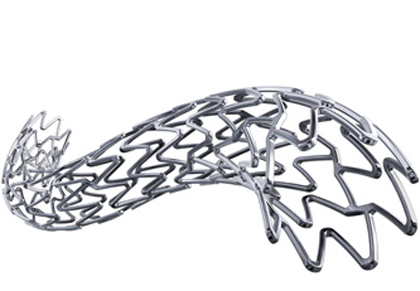Courtesy of Dr. Guillermo Migliaro.
 Technological advancements in drug-eluting stents (DES) have shown significant improvement as regards the safety and efficacy of these devices. DES are considered to be the golden standard for the treatment of percutaneous coronary interventions.
Technological advancements in drug-eluting stents (DES) have shown significant improvement as regards the safety and efficacy of these devices. DES are considered to be the golden standard for the treatment of percutaneous coronary interventions.
DES with permanent or durable polymers (DP) have been associated with local inflammatory reactions and the subsequent risk of thrombosis. DES with biodegradable polymers (BP) have been developed to mitigate this effect, providing both the high efficacy of a DES and the safety of a conventional bare metal stent.
The SYNERGY stent is an everolimus DES with BP, a platinum chromium scaffold and thin struts. While the Evolve II trial has shown the safety and efficacy of SYNERGY stents in simple lesions, their usefulness for complex lesions should be considered “off-label.” Currently, there are no available data supporting the use of SYNERGY stents in such a context.
The aim of this study was to compare the safety and efficacy profile of SYNERGY stents and that of an everolimus DES with a DP (Xience).
To this end, 2001 consecutive patients treated with Synergy stents (n = 400) or Xience stents (n = 1601) at two Italian sites between 2013 and 2015 were included in an observational registry. Propensity score matching was applied to balance this population and obtain two cohorts of patients with similar baseline risk profiles.
The primary endpoint was major adverse cardiac events (MACE, defined as the composite of all-cause death, myocardial acute infarction, and the need for new revascularisation) after a one-year follow-up.
Patients or lesions were considered complex if they met at least one of the following criteria:
- primary angioplasty,
- lesions in the left main coronary artery,
- chronic occlusion,
- in-stent restenosis,
- lesions in aorta-coronary bridge grafts,
- disease in at least two vessels or long lesions >34 mm.
Among 391 matched pairs of patients treated, 253 pairs (63%) were identified as complex. At one-year follow-up, MACE rates did not differ significantly between the groups (9.9% vs. 9.5%; hazard ratio [HR]: 1.04; 95% confidence interval [CI]: 0.79 to -0.72; p = 0.830). No significant differences were found between the groups as regards simple lesions or the individual variables making up the composite endpoint, either. No definite stent thrombosis cases were reported for this patient population.
The study concludes that, in this multicenter registry, SYNERGY stents appear to be as safe and effective as XIENCE stents, irrespective of patient or lesion complexity.
Editorial
This real-world registry is the largest to date involving complex patients or lesions treated with SYNERGY stents.
Its limitations are those of an observational study, although the use of propensity score matching strengthens it and allows for hypotheses at 3 levels:
- SYNERGY stents are safe and effective for the treatment of complex lesions.
- No changes in stent behavior are observed upon changes in lesion complexity.
- The rate of stent thrombosis for this complex-patient registry is 0%.
These findings should be verified through studies at a larger scale with longer follow-up periods, since differences may be encountered in those conditions.
Courtesy of Dr. Guillermo Migliaro. Buenos Aires German Hospital, Argentina.
Original title: Clinical Outcomes of Bioresorbable vs. Durable Polymer Coated Everolimus Eluting Stents in Real Word Complex Patients.
Reference: Mennuni M et al. Eurointervention 2017;12:1977-1986.
Get the latest scientific articles on interventional cardiologySubscribe to our weekly newsletter
We are interested in your opinion. Please, leave your comments, thoughts, questions, etc., below. They will be most welcome.





